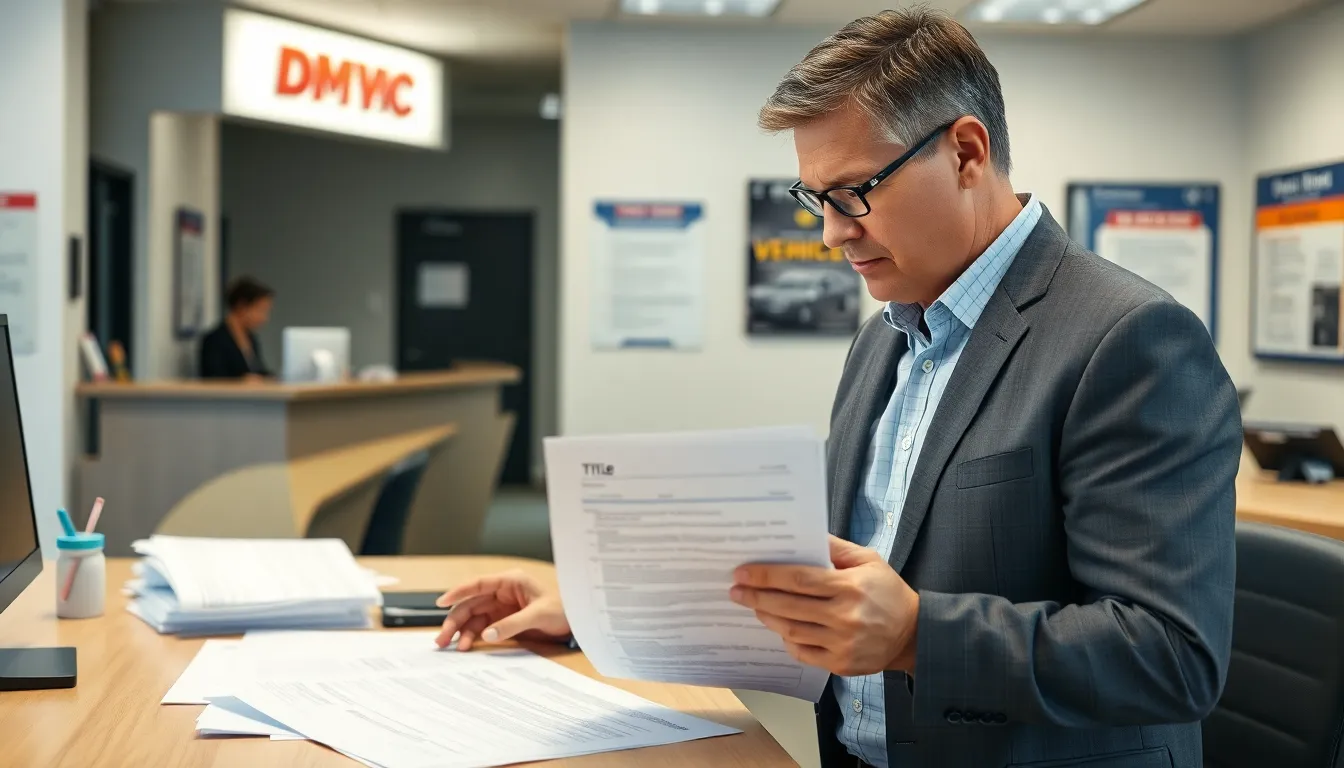Table of Contents
ToggleNavigating the title transfer process can feel like trying to find a needle in a haystack—if the haystack were also on fire. But don’t worry, it’s not as daunting as it seems! This essential step ensures that ownership of a vehicle or property officially shifts from one party to another. Think of it as a handshake with legal flair, where both parties can finally breathe easy knowing everything’s above board.
Whether you’re buying your dream car or selling that quirky vintage trailer, understanding the title transfer process can save time, headaches, and maybe even a few awkward conversations. With the right knowledge, you can turn what feels like a bureaucratic maze into a straightforward journey. So, buckle up and get ready to dive into the nitty-gritty of title transfers—because who said legal processes couldn’t be a little fun?
Understanding Title Transfer Process
The title transfer process serves as a key step in changing ownership of a vehicle or property. Completing this process ensures clarity and legality in ownership documentation.
Definition of Title Transfer
Title transfer represents the official act of moving ownership from one party to another, marking the change in rights and responsibilities. In vehicles, this occurs when the seller completes the title form and signs it over to the buyer. For real estate, it involves executing a deed that conveys legal ownership rights. Each state may have its specific requirements for this documentation, influencing how individuals must approach the transfer. Understanding these nuances simplifies the process and reduces potential risks for both sides involved in the transaction.
Importance of Title Transfer
Title transfer holds significant importance in securing legal proof of ownership. Without a proper title, individuals may face difficulties in proving ownership in cases of disputes or potential theft. Ensuring the title is correctly transferred protects buyers from acquiring a vehicle or property that may have liens or unresolved issues. Additionally, maintaining accurate ownership records aids in future transactions, such as sales or refinancing. Engaging in the title transfer process with care contributes to a smoother experience and fosters trust between involved parties.
Steps in the Title Transfer Process
Title transfer involves several crucial steps that ensure a smooth transition of ownership.
Preparing for Title Transfer
Research is key before starting a title transfer. It involves checking the title for any liens or claims. Gathering necessary documents, such as identification and proof of purchase, streamlines the process. Understanding local requirements also helps avoid complications later on. Engaging with the appropriate local authorities or DMV can provide important guidance. This groundwork lays the foundation for a successful transfer.
Completing the Necessary Documentation
Filling out required forms accurately is essential for a proper title transfer. Most regions need a title application and a bill of sale. Owners must provide their signatures and any co-owner information. It’s important to review all submitted details for accuracy. Specifics, like odometer readings for vehicles, often require inclusion to comply with regulations. Failing to complete documentation correctly could delay processing.
Finalizing the Transfer
Executing the final steps completes the title transfer. Submitting all forms and payments to the appropriate agency is crucial. Recipients usually receive a new title, which serves as proof of ownership. Allowing time for processing ensures all records are updated accurately. Once the transfer is finalized, both parties should keep copies of the transaction for their records. Following these steps enhances clarity and security in the transaction.
Common Challenges in Title Transfer
Title transfer can pose several challenges that individuals must navigate effectively.
Legal Complications
Legal complications often arise during title transfers. Failure to resolve liens can delay the process significantly. In some cases, conflicting ownership claims may require legal intervention to clarify title status. Parties may encounter disputes over property descriptions or boundary lines, complicating the situation further. Engaging a legal professional early can prevent future headaches and streamline the transfer process.
Delays in Processing
Delays in processing can impede smooth title transfers. Local government agencies typically handle processing times, which may vary significantly based on jurisdiction. Incomplete applications or missing documentation can further extend these delays. Individuals should anticipate potential holdups during peak times, such as the end of the month when many transactions occur. Planning ahead and submitting everything accurately can help mitigate this risk.
Miscommunication Among Parties
Miscommunication among parties often leads to complications in title transfers. Clear communication regarding expectations and responsibilities is essential throughout the process. Each party must understand the required documentation, deadlines, and payments needed for a successful transfer. Regular check-ins and status updates can prevent misunderstandings. Establishing open lines of communication fosters a smoother transaction and builds trust between involved parties.
Best Practices for Smooth Title Transfers
Smooth title transfers depend on several best practices. Start by establishing clear communication between all parties involved, including buyers, sellers, and any intermediaries. Regular updates help everyone stay informed, reducing the chances of misunderstandings. Consistent check-ins allow parties to address concerns promptly, fostering a collaborative atmosphere.
Working with professionals simplifies the process immensely. Engaging real estate agents, title companies, or legal experts ensures a thorough understanding of local laws and regulations. These professionals can assist in completing all necessary paperwork accurately. Trusting experienced individuals helps mitigate risks associated with title transfers and can expedite the process significantly.
Keeping records organized plays a crucial role in ensuring a successful title transfer. Document every step taken during the process, including communications and transactions. Create a dedicated folder for all relevant paperwork, such as forms, payments, and correspondence. Having these documents accessible not only streamlines the transaction, but also serves as crucial proof of ownership and agreement in future discussions.
Conclusion
Navigating the title transfer process doesn’t have to be daunting. With a clear understanding of the steps involved and effective communication among all parties, it can become a straightforward task. Embracing the process and seeking professional guidance can significantly reduce risks and enhance the overall experience. By staying organized and informed, individuals can ensure a smooth transition of ownership that protects their interests and fosters trust. Ultimately, mastering the title transfer process opens the door to successful transactions and peace of mind for everyone involved.




